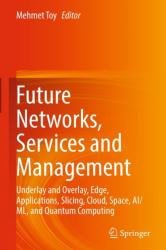 Название: Future Networks, Services and Management: Underlay and Overlay, Edge, Applications, Slicing, Cloud, Space, AI/ML, and Quantum Computing
Название: Future Networks, Services and Management: Underlay and Overlay, Edge, Applications, Slicing, Cloud, Space, AI/ML, and Quantum ComputingАвтор: Mehmet Toy
Издательство: Springer
Год: 2021
Страниц: 461
Язык: английский
Формат: pdf (true)
Размер: 15.3 MB
This book describes the networks, applications, services of 2030 and beyond, their management. Novel end-to-end network and services architectures using cloud, wired, wireless, and space technologies to support future applications and services are presented. The book ties key concepts together such as cloud, space networking, network slicing, AI/ML, edge computing, burst switching, and optical computing in achieving end-to-end automated future services. Expected future applications, services, and network and data center architectures to support these applications and services in the year 2030 and beyond, along with security, routing, QoS, and management architecture and capabilities are described. The book is written by recognized global experts in the field from both industry and academia.
In parallel to the growth in cloud applications and services, applications and services with strict performance requirements are growing. This growth triggered Multi-access Edge Computing (MEC) applications and services where MEC devices are located either at customer premises or at nearby Communication Service Provider Points of Presence (POPs). As new applications and services are being developed, hiding complexity from users by simplifying user interfaces and automation of service order and delivery is the primary goal of Service Providers. Intent-based Networking, Network Slicing, and Artificial Intelligence (AI)/Machine Learning (ML) techniques are employed for these purposes.
In this decade and beyond, we expect more bandwidth hungry applications with strict performance requirements such as holographic and robotic applications to be developed; and applications that are in their infancy such as those for self-driven cars are to be matured. In order to support future applications and associated services, we expect underlay and overlay networks to go through dramatic changes again. 6G and Quantum Computing are among the technologies on the horizon to make these changes possible.
Future networks will be heterogonous as the current networks. The main difference would be that the future networks will include hyperscalers and space networks and end-to-end automation. Perhaps the transaction-based usage billing for services is highly likely.
In this book, we describe future applications and services, current and future underlay and overlay networks, an overall service architecture, an overall management architecture, and various techniques in building future networks and services such as routing, security, quality of service (QoS), burst switching, 5G and 6G, MEC, AI/ML, Application Programming Interfaces (APIs), Network Slicing, and Quantum Computing.
- Describes current and future communications applications, services, and their requirements in this decade and beyond;
- Includes novel future network and management architectures to support given applications and services;
- Describes edge computing, network slicing, and space networking in support of end–to-end network and services architectures.
Скачать Future Networks, Services and Management: Underlay and Overlay, Edge, Applications, Slicing, Cloud, Space, AI/ML, and Quantum Computing